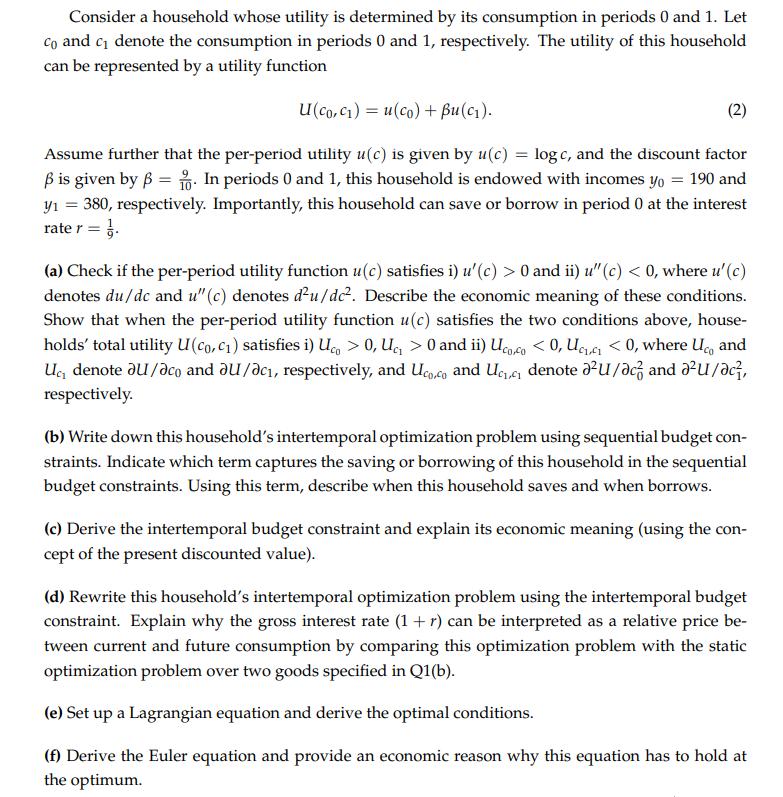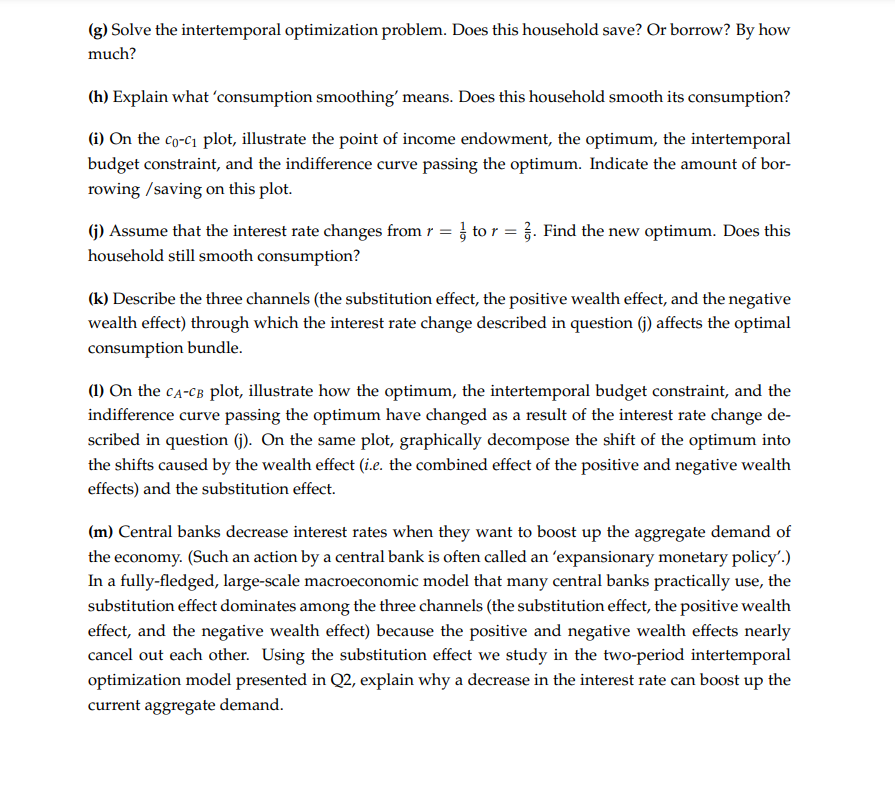Answered step by step
Verified Expert Solution
Question
1 Approved Answer
Consider a household whose utility is determined by its consumption in periods 0 and 1. Let Co and c denote the consumption in periods


Consider a household whose utility is determined by its consumption in periods 0 and 1. Let Co and c denote the consumption in periods 0 and 1, respectively. The utility of this household can be represented by a utility function U(co, c)u(co) + Bu(c1). (2) Assume further that the per-period utility u(c) is given by u(c) = log c, and the discount factor is given by B. In periods 0 and 1, this household is endowed with incomes yo = 190 and y = 380, respectively. Importantly, this household can save or borrow in period 0 at the interest rate r = . (a) Check if the per-period utility function u(c) satisfies i) u'(c) > 0 and ii) u" (c) < 0, where u'(c) denotes du/dc and u" (c) denotes du/dc. Describe the economic meaning of these conditions. Show that when the per-period utility function u(c) satisfies the two conditions above, house- holds' total utility U(co, c) satisfies i) Uco > 0, U > 0 and ii) Ucoco < 0, U < 0, where Uc and Uc denote au/aco and au/ac, respectively, and Uco.co and Uc denote au/ac and a/ac, respectively. (b) Write down this household's intertemporal optimization problem using sequential budget con- straints. Indicate which term captures the saving or borrowing of this household in the sequential budget constraints. Using this term, describe when this household saves and when borrows. (c) Derive the intertemporal budget constraint and explain its economic meaning (using the con- cept of the present discounted value). (d) Rewrite this household's intertemporal optimization problem using the intertemporal budget constraint. Explain why the gross interest rate (1+r) can be interpreted as a relative price be- tween current and future consumption by comparing this optimization problem with the static optimization problem over two goods specified in Q1(b). (e) Set up a Lagrangian equation and derive the optimal conditions. (f) Derive the Euler equation and provide an economic reason why this equation has to hold at the optimum. (g) Solve the intertemporal optimization problem. Does this household save? Or borrow? By how much? (h) Explain what 'consumption smoothing' means. Does this household smooth its consumption? (i) On the co-c plot, illustrate the point of income endowment, the optimum, the intertemporal budget constraint, and the indifference curve passing the optimum. Indicate the amount of bor- rowing/saving on this plot. (j) Assume that the interest rate changes from r = household still smooth consumption? tor. Find the new optimum. Does this (k) Describe the three channels (the substitution effect, the positive wealth effect, and the negative wealth effect) through which the interest rate change described in question (j) affects the optimal consumption bundle. (1) On the CA-CB plot, illustrate how the optimum, the intertemporal budget constraint, and the indifference curve passing the optimum have changed as a result of the interest rate change de- scribed in question (j). On the same plot, graphically decompose the shift of the optimum into the shifts caused by the wealth effect (i.e. the combined effect of the positive and negative wealth effects) and the substitution effect. (m) Central banks decrease interest rates when they want to boost up the aggregate demand of the economy. (Such an action by a central bank is often called an 'expansionary monetary policy'.) In a fully-fledged, large-scale macroeconomic model that many central banks practically use, the substitution effect dominates among the three channels (the substitution effect, the positive wealth effect, and the negative wealth effect) because the positive and negative wealth effects nearly cancel out each other. Using the substitution effect we study in the two-period intertemporal optimization model presented in Q2, explain why a decrease in the interest rate can boost up the current aggregate demand.
Step by Step Solution
There are 3 Steps involved in it
Step: 1

Get Instant Access to Expert-Tailored Solutions
See step-by-step solutions with expert insights and AI powered tools for academic success
Step: 2

Step: 3

Ace Your Homework with AI
Get the answers you need in no time with our AI-driven, step-by-step assistance
Get Started


